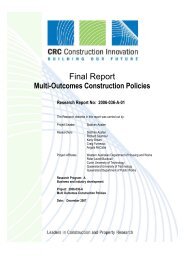2006-07 - Construction Innovation
2006-07 - Construction Innovation
2006-07 - Construction Innovation
You also want an ePaper? Increase the reach of your titles
YUMPU automatically turns print PDFs into web optimized ePapers that Google loves.
PROGRAM C: DELIVERY AND MANAGEMENT OF BUILT ASSETS<br />
Delivering a Re-Life <strong>Construction</strong> Project<br />
Research project 2003-026-C<br />
Sustainable Infrastructure in Aggressive Environments<br />
Research project 2004-018-C<br />
Project duration: 1 August 2004–30 September <strong>2006</strong><br />
Project leader: Jay Yang, QUT<br />
Project members: John Holland Group: Bruce Carlyle<br />
Queensland Department of Public Works: Selwyn Clark,<br />
Stuart Grierson<br />
QUT: Soon Kam Lim<br />
Rider Levett Bucknall: Michael Gilligan, John Oliver<br />
RMIT: Arun Kumar, Tom Molyneaux, Chintha Perera, Sujeeva<br />
Setunge, Srikanth Venkatesan<br />
University of Western Sydney: Mary Hardie, Graham Miller<br />
Thousands of buildings in Australian cities<br />
have reached an age when decisions must<br />
be made about their future. Products of the<br />
1970s building boom, these buildings no<br />
longer meet tenants’ requirements or energy<br />
efficiency standards, and a decision must<br />
be taken to demolish and build new, or “relife”<br />
through refurbishment. To assist in this<br />
process, this re-life project has developed<br />
a set of guidelines to test the commercial,<br />
technical and environmental viability of relifing<br />
projects. With the growing commitment<br />
Jay Yang<br />
to sustainability, improving existing building stock is an attractive<br />
option and it is estimated up to 50 per cent of annual capital budgets<br />
will go to re-lifing by the year 2020. The research team studied the<br />
re-lifing of three 30-to 40-year-old government buildings in Brisbane,<br />
Melbourne and Sydney to investigate the characteristics of re-life<br />
projects including the identification and mitigation of risks, issues of<br />
decanting and existing tenants, identification of existing structure and<br />
services, work scheduling, occupational health and safety issues for<br />
construction personnel and tenants, demolition, waste and recycling,<br />
issues of quality and workmanship, cost planning and cost modelling<br />
methodologies. Outcomes of the research are available to industry<br />
online through the Your Building sustainable commercial buildings<br />
web portal.<br />
Project duration: 1 July 2005–31 December <strong>2006</strong><br />
Project leader: Sujeeva Setunge, RMIT<br />
Project members: Queensland Department of Main Roads:<br />
John Fenwick, Peter Rotolone, Lex Vanderstaay<br />
QUT: Matthew Humphreys<br />
RMIT: Rebecca Gravina, Tom Molyneaux, Srikanth Venkatesan<br />
This project developed a diagnostic tool<br />
that assists in the interpretation of distress<br />
symptoms in bridges exposed to aggressive<br />
environments. Distress mechanisms<br />
pertinent to Queensland bridge stock have<br />
been investigated and the methodology of<br />
diagnosing from visual symptoms has been<br />
developed. Based on further analysis of<br />
about 30 bridges, a database of parameters<br />
and issues to be considered in relating the<br />
symptoms of distress to their mechanisms<br />
Sujeeva Setunge<br />
has been developed using a mind-map<br />
analysis technique. This has led to the systematic documentation<br />
of a rule based matrix that includes three levels of confidence (High,<br />
Medium and Low). Based on this documentation, a software tool<br />
(BridgeDIST) has been developed with a “knowledge base” and an<br />
inference engine. Imprecise information has been evaluated using a<br />
fuzzy-logic approach. The developed software is simple in application<br />
with an open-ended architecture; this helps experts to create their<br />
own new rule-bases, as and when sufficient expertise has now<br />
been gained. Furthermore, the software can potentially be linked to<br />
the bridge management systems and future deterioration of bridge<br />
stock could be predicted. A hardcopy costing module has been<br />
developed to accompany the software tool which evaluates the cost<br />
of repairs for a given scenario. The outcomes of this project will inform<br />
Queensland Department of Main Roads approaches to rehabilitating<br />
concrete structures in marine environments.<br />
Jay Yang. Image © Erika Fish, QUT.<br />
Image © Peter Brandon.<br />
34

















